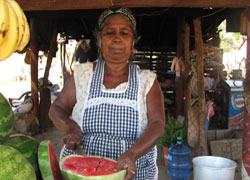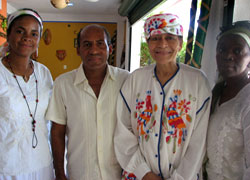[Editor’s Note: This article was published online on May 13, 2009 and The Final Call will continue to reprint articles written by our late and dear Mother Tynnetta Muhammad.]

“Go thou and thy brother with My messages and be not remiss in remembering Me. Go both of you to Pharaoh, surely he is inordinate; Then speak to him a gentle word, haply he may mind or fear. They said: Our Lord, we fear lest he hasten to do evil to us or be inordinate. He said: Fear not, surely I am with you–I do hear and see.” –Holy Qur’an, Surah 20, verses 42-46
The Honorable Elijah Muhammad has stated that it was suicide for America to have brought our people from Africa to serve them in captive slavery. However, in fulfillment of Divine Prophecy, we have served this nation as foreigners in a strange land over 400 years, and the time of our delivery draws near. Since the coming of Christopher Columbus in 1492 and the inception of the Portugese Slave Traders shortly thereafter, we were transported as cargo into the Americas. Many of our foreparents were brought to the Caribbean island of Cuba and Santo Domingo. Later, we were brought to Mexico from there by the Spanish conquerors under Hernando Cortez in 1521 and 1522 from, as free slaves, soldiers and domestic servants. Those members of our family served in Mexico on both the Atlantic-Caribbean side through the Gulf of Mexico to the Pacific side in the states of Guerrero, near Alcapulco to a small 200 mile strip of the Pacific Coast called Costa Chica.

This part of Mexico runs into the state of Oaxaca. This period of the Spanish conquest and domination of Mexico began within a period of approximately two to three years after Cortez landed in Veracruz in 1519. Then in 1555, 64 years after the coming of Columbus, the British under the slave trader, John Hawkins, began trafficking in slaves from Africa, bringing our foreparents to this part of America on a slave ship named Jesus. Counting another 64 years from that time we come to the famous date 1619 recording our presence in Jamestown, Virginia, which they count as the beginning of the slave period. Now, we have a brief picture of two parts of the slave trade during the Diaspora which dispersed members of our African family throughout the continent of the Americas. We who were brought to the United States knew very little or nothing about how to make contact with our family members dispersed in Mexico, Central and South America because we were cut off from our own, not only in North America were we divided and separated from plantation to plantation, but we were unaware that we were also separated and divided elsewhere in the Western Hemisphere.
Under the Spanish occupation of Mexico in the slave trade, the attempt was made to bring to Mexico members of our Phillipino, Malaysian, and even Chinese family members from Asia. This proved futile. Due to their weaker, physical condition they could not adopt to this severe kind of labor and ran away or escaped into the surrounding hills and mountains leaving the Black man and family as the stronger working force even in the mining industry for gold and silver and extraction of other natural resources that the Europeans craved for their economic prosperity. This experience we shared in the North American slave trade where our Indigenous brothers of the Indian nation could not endure the labor and torture that our foreparents were subjected to. We have proved to be the survivors. In the last several days of March and the first few days of April of this year, a few sisters visited me from the United States to retrace our footsteps. As we entered some of the grounds and villages where our family members are still found today scattered throughout this area of the Pacific Coast near Alcapulco in the region called Costa Chica, we were surprised to find African people, some mixed with the Indigenous inhabitants called Afro-mestizo and others who were purely akin to our own Black brothers and sisters living in the United States. They, too, as we, are marginalized and victims of racism and discrimination.
The following articles and commentaries were written by my two fellow travelers from our Nation of Islam, Dr. Darnita Muhammad and Sister Callie Muhammad, both health practitioners who prescribe to the healing power and methodology of How to Eat to Live by the Honorable Elijah Muhammad. Our guide to Costa Chica was a sister that we met recently in Cuernavaca named Janetta Housmen. Some of her photos are featured in this article. Dr. Darnita’s article first and then Sister Callie.
Sis Dr. Darnita: My recent visit to Costa Chica, Mexico in the state of Guerrero (as part of the MXODUS African Diaspora Health and Research Team) was an amazing and humbling experience. To find members of our own family, an Indigenous group of “Asiatic” Black African-Mexicans living in remote areas near the Pacific Coast of Mexico bears witness to the fact that our people have been dispersed all over the planet, even hidden in areas close to where most of us live. The greatest depths of this knowledge bears witness to the Divine Teachings of the Most Honorable Elijah Muhammad and present Work and Guidance from the Honorable Minister Louis Farrakhan that is connecting the original people of the earth together.
Being in Costa Chica was a tremendous reminder of our journey of enslavement in the hulls of ships that took us to areas that we may not have realized. The lies, deceit and tricks put on the original Black man were terrific.I thank Allah for allowing me to participate as a humbled student in this aspect of a Greater Work.Our family members are being found and it is time for our rise, and by Allah’s grace and mercy, we can serve and work in the healing of ourselves, our Nation and our people all over the planet earth.

Sister Callie: The first stop on our itinerary was the town, Acapulco, in the state of Guerrero on the Pacific Coast. This was my first visit to the Pacific Ocean. I was immediately reminded of our Lessons and the measurement of the Pacific Ocean, which is 68,634,000 square miles. It is the largest and the deepest of all the oceans. From Acapulco, we traveled by car for approximately four hours up the coast to Costa Chica. The rural region of Costa Chica is home to most of Mexico’s Afro-Mexican or Afro-mestizo population, many of whom are descended from the Cinamorrones or fugitive slaves. Costa Chica is also home to the humble but powerful, Museo De Las Culture Afro-mestizas or the Museum of Afro-mestizo Culture. The museum provided a great deal of insight into the history of the Afro-mestizo. It was here that I learned:
– The first African slave in Mexico was Juan Cortes, who arrived with the conquistador Hernan Cortes in 1519. The native people of Mexico reportedly took Juan Cortes to be a God.
– Juan Garrido, a free Black man, is said to be the first man to sow wheat in Mexico.
– African slaves were originally brought to Mexico from Angola by the Portuguese to work in the silver mines.
I would like to thank Mother Tynnetta Muhammad for inviting me to accompany her to Costa Chica, Mexico. My encounter with this particular history of Mexico was very enlightening. Everywhere we ventured in Costa Chica, we saw people with distinctive African features–people who looked just like our own family members. I gained a much deeper interest and respect for the history and culture of Mexico and the Afro-mestizo people.
“So go you to him and say: Surely we are two messengers of thy Lord; so send forth the Children of Israel with us; and torment them not. Indeed we have brought to thee a message from thy Lord, and peace to him who follows the guidance. It has indeed been revealed to us that punishment will overtake him who rejects and turns away. (Pharaoh) said: Who is your Lord, O Moses? He said: Our Lord is He Who gives to everything its creation, then guides (it).” –Holy Qur’an, Surah 20, verses 47-50
To be continued.












